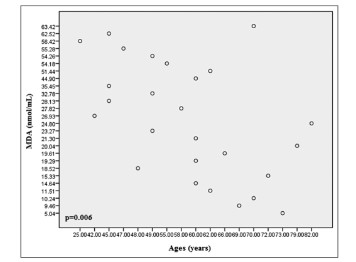Serum levels of oxidative stress marker malondialdehyde in breast cancer patients in relation to pathohistological factors, estrogen receptors, menopausal status, and age
DOI:
https://doi.org/10.17532/jhsci.2018.263Keywords:
breast cancer, oxidative stress, malonaldehideAbstract
Introduction: The aim of this study was to determine the serum levels of malondialdehyde (MDA) in patients with invasive breast cancer in relation to its serum levels in patients with benign breast disease, and to investigate correlation between MDA serum levels with pathohistological prognostic factors (tumor size, lymph node involvement, and histologic grade [HG]), estrogen receptor (ER) status, and with breast cancer patient’s age and menopausal status.
Methods: A total of 43 with well-documented invasive breast cancer were included in this study: 27 with positive axillary’s lymph nodes, and 16 with negative axillary’s lymph nodes, and 39 patients with findings of benign breast diseases. MDA determination in serum of breast cancer and benign breast disease patients was performed by the fluorimetric method, immunohistochemical staining was performed for ER, and routine pathohistological examination was conducted for pathohistological factors.
Results: MDA serum levels in breast cancer patients were significantly higher than MDA serum levels in benign breast disease patients (p = 0.042). No statistically significant difference between MDA serum levels in breast cancer patients with and without lymph node metastases was found (p = 0.238). No statistically significant correlations between MDA serum levels and tumor size (p = 0.256), HG (p = 0.124), or number of positive lymph nodes (0.113) were found. A statistically significant correlation between serum MDA levels and ages of breast cancer patients with lymph node metastases was found (p = 0.006).
Conclusion: Obtained results support the importance of MDA in the carcinogenesis of breast cancer. According to our findings, serum level of MDA could not be a useful prognostic factor in breast cancer.
Downloads











